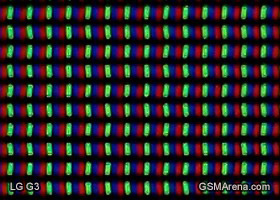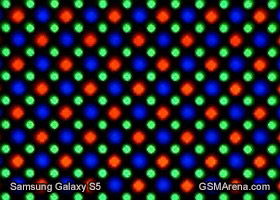LG G3 vs Samsung Galaxy S5: South Korean derby
South Korean derby
Displays
Going into this shootout, you'd expect that it's pretty clear which of the two devices will have a distinct advantage when it comes to display fidelity. But before we go declaring the winner outright, let's keep in mind that there's more to a screen than the number of pixels it has. Contrast, colors, and sunlight legibility all factor into how good a particular display is, and we'll be taking everything into account before we give a final verdict.
Both phones represent each company's screen-making expertise. Samsung put their Super AMOLED display on the Galaxy S5, while the LG G3 sports a True HD-IPS + LCD.
The Galaxy S5 has a 5.1" screen of 1080p resolution and 432ppi. The G3's panel is of 1440 x 2560px resolution, which at 5.5" comes out to a pixel density of about 534ppi. Looking at them both under our microscope under the same magnification, you can clearly see which one is which.


Samsung took several years to perfect Super AMOLED for it to finally offer the most accurate colors in the market. Using the display mode settings you can tweak that to a more saturated look if you prefer. It has excellent viewing angles and practically infinite contrast too.
The G3 is another story, however, as it's markedly worse both at 50% and 100% brightness. At 100% brightness the black luminance is among the highest we've seen, while the whites are markedly dimmer than on the G2. Here's how it stacks up to other top flagships:
| Display test | 50% brightness | 100% brightness | ||||
| Black, cd/m2 | White, cd/m2 | Black, cd/m2 | White, cd/m2 | |||
| LG G3 | 0.14 | 109 | 763 | 0.72 | 570 | 789 |
| Samsung Galaxy S5 | 0 | 274 | ∞ | 0 | 529 | ∞ |
| Sony Xperia Z2 | - | - | - | 0.41 | 488 | 1195 |
| Sony Xperia Z1 | - | - | - | 0.38 | 580 | 1513 |
| Sony Xperia Z | - | - | - | 0.70 | 492 | 705 |
| Oppo Find 7a | 0.33 | 280 | 842 | 0.68 | 580 | 852 |
| Samsung Galaxy S4 | 0 | 201 | ∞ | 0 | 404 | ∞ |
| HTC One (M8) | 0.20 | 245 | 1219 | 0.46 | 577 | 1256 |
| LG G2 | 0.10 | 149 | 1522 | 0.45 | 667 | 1495 |
| HTC Butterfly S | 0.15 | 165 | 1117 | 0.43 | 451 | 1044 |
| Apple iPhone 5 | 0.13 | 200 | 1490 | 0.48 | 640 | 1320 |
The two screens differ wildly in sunlight legibility as well. The S5 is among the best we've seen in the current batch of flagships, while the LG G3's highly reflective display will make it a challenge to make out in bright environments.
Sunlight contrast ratio
-
Nokia 808 PureView
4.698 -
Apple iPhone 5
3.997 -
Samsung Galaxy Note 3
3.997 -
Samsung Galaxy S5
3.549 -
Samsung I9300 Galaxy S III
3.419 -
Nokia Lumia 925
3.402 -
Samsung I9505 Galaxy S4
3.352 -
Samsung Omnia W
3.301 -
Samsung Galaxy S
3.155 -
Samsung Galaxy S4 mini
3.127 -
Samsung Galaxy S4 zoom
3.118 -
Nokia N9
3.069 -
Samsung Galaxy Note
2.970 -
Sony Xperia Z1
2.950 -
HTC One S
2.901 -
BlackBerry Q10
2.856 -
Samsung Galaxy S II
2.832 -
Samsung Galaxy S II Plus
2.801 -
BlackBerry Z30
2.790 -
Huawei Ascend P1
2.655 -
Sony Xperia ZR
2.672 -
Nokia Lumia 900
2.562 -
HTC One Max
2.537 -
Nokia Lumia 720
2.512 -
HTC One
2.504 -
Sony Xperia Z
2.462 -
Samsung Galaxy S III mini
2.422 -
HTC One (M8)
2.371 -
Motorola RAZR i
2.366 -
Samsung Galaxy Note II
2.307 -
Oppo Find 7a
2.279 -
Apple iPhone 4S
2.269 -
HTC Desire 600 dual sim
2.262 -
LG Nexus 5
2.228 -
HTC One X
2.158 -
Nokia N8
2.144 -
Oppo Find 5
2.088 -
BlackBerry Z10
2.051 -
Apple iPhone 4
2.016 -
HTC One mini
2.003 -
LG G2
1.976 -
Sony Ericsson Xperia ray
1.955 -
Sony Xperia Z2
1.944 -
Samsung Galaxy Camera
1.938 -
LG G Pro 2
1.922 -
HTC Butterfly
1.873 -
Huawei Ascend P6
1.865 -
LG G3
1.820 -
Sony Xperia V
1.792 -
Sony Xperia U
1.758 -
Meizu MX3
1.754 -
Sony Xperia T2 Ultra
1.740 -
LG Optimus 4X HD
1.691 -
HTC One V
1.685 -
BlackBerry Q5
1.682 -
LG Optimus Vu
1.680 -
LG Optimus GJ
1.666 -
HTC Desire V
1.646 -
Samsung Galaxy Ace 3
1.622 -
Sony Xperia Z Ultra
1.578 -
Samsung Galaxy Core
1.563 -
LG Optimus G Pro
1.552 -
LG Optimus 3D
1.542 -
Samsung Galaxy Core LTE
1.542 -
Nokia Asha 302
1.537 -
Sony Xperia M
1.473 -
Nokia Lumia 610
1.432 -
Samsung Galaxy Grand Neo
1.393 -
Gigabyte GSmart G1355
1.361 -
Samsung Galaxy Grand
1.321 -
HTC Desire C
1.300 -
Nokia Asha 501
1.270 -
LG Optimus L7
1.269 -
LG Optimus L9
1.227 -
Meizu MX
1.221 -
Sony Xperia E dual
1.203 -
Samsung Galaxy Pocket
1.180 -
Sony Xperia tipo
1.166 -
Samsung Galaxy mini 2
1.114
We've also seen Samsung's Air View, which detects your finger at about an inch distance thanks to its highly sensitive digitizer. It triggers special previews of image folders, messages and calendar events.
Winner: LG G3. Despite its inferior color, contrast, and sunlight legibility, the bigger screen diagonal and the higher resolution still has its say at the end of the day. The QHD resolution may not be readily apparent when it comes to browsing the interface, but it does make a difference when you see the ultra-crisp text in webpages, and especially in watching QHD videos or playing games. As more QHD content becomes available, the advantage of having the G3 display will become even more pronounced.
Connectivity
Both phones are powered by Qualcomm chipsets and enjoy all the connectivity benefits that come with it. The Galaxy S5 beats out the G3 in the number of supported bands, especially when it comes to LTE, though both should have you well covered for whatever region you buy the device in. The two flagships also enjoy the fastest mobile data around with Cat. 4 LTE (up to 150Mbps down and 50Mbps up), but even without an LTE network where you are, they'll still go quite fast at 42.2Mbps down and 5.76 up courtesy of HSPA.
Local connections are blazing fast as well thanks to dual-band Wi-Fi 802.11ac (a/b/g/n are supported too). Bluetooth 4.0 is available for connecting accessories, although the S5 has the advantage of EDR in this regard. Both phones also support the ANT+ standard, which is popular with sports accessories.
Wired connectivity is where the two flagships start to diverge. The Samsung Galaxy S5 has a microUSB 3.0 port, which will provide faster data transfers between the phone and a computer with a USB 3.0 port. It also integrates MHL 2.1, which means it can, with the right adapter, output 1080p video.
Both phones sport USB On-the-go as well, which means you'll be able to plug in expandable storage drives, although again you need the correct adapter.


microUSB 2.0 on the LG G3 • microUSB 3.0 on the Galaxy S5
Both phones feature NFC for use with tags and easy pairing with most devices. They also both have IR blasters to control electronic equipment at home, including TVs, disc players and even air conditioners. LG's QRemote app seems slightly more robust in this regard, but a software update or app store download could even things out in that regard.


Both devices have an IR blaster up top
Winner: Tie. The key features - 150Mbps LTE, Wi-Fi 802.11ac, Bluetooth 4.0 and NFC - are evenly split.
The Galaxy S5 has USB 3.0, which offers faster transfer rates for those who still use cables.
Reader comments
- Anonymous
- 17 Jun 2021
- L2Q
why lg g3 is a good phone right
- Anonymous
- 02 Mar 2020
- 2Au
hey ferdie are you the one who killed betty?
- Fenty
- 05 Sep 2019
- ptu
We are in the middle of 2019 and i missed those years and days. everything was better and cooler and mor loveable than now. 💔
